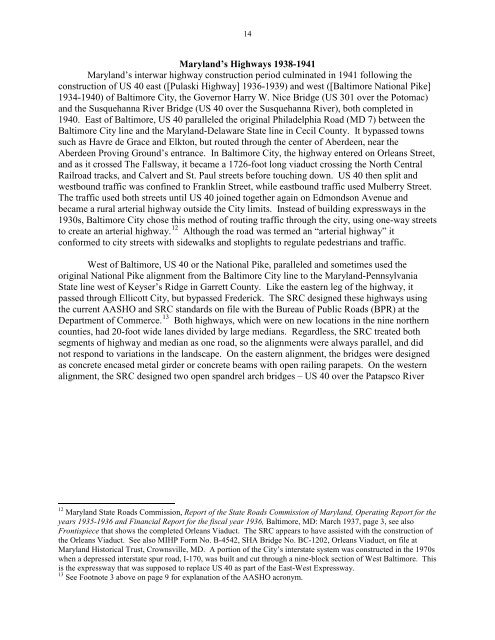TOMORROW'S ROADS TODAY - Maryland State Highway ...
TOMORROW'S ROADS TODAY - Maryland State Highway ...
TOMORROW'S ROADS TODAY - Maryland State Highway ...
You also want an ePaper? Increase the reach of your titles
YUMPU automatically turns print PDFs into web optimized ePapers that Google loves.
14<br />
<strong>Maryland</strong>’s <strong>Highway</strong>s 1938-1941<br />
<strong>Maryland</strong>’s interwar highway construction period culminated in 1941 following the<br />
construction of US 40 east ([Pulaski <strong>Highway</strong>] 1936-1939) and west ([Baltimore National Pike]<br />
1934-1940) of Baltimore City, the Governor Harry W. Nice Bridge (US 301 over the Potomac)<br />
and the Susquehanna River Bridge (US 40 over the Susquehanna River), both completed in<br />
1940. East of Baltimore, US 40 paralleled the original Philadelphia Road (MD 7) between the<br />
Baltimore City line and the <strong>Maryland</strong>-Delaware <strong>State</strong> line in Cecil County. It bypassed towns<br />
such as Havre de Grace and Elkton, but routed through the center of Aberdeen, near the<br />
Aberdeen Proving Ground’s entrance. In Baltimore City, the highway entered on Orleans Street,<br />
and as it crossed The Fallsway, it became a 1726-foot long viaduct crossing the North Central<br />
Railroad tracks, and Calvert and St. Paul streets before touching down. US 40 then split and<br />
westbound traffic was confined to Franklin Street, while eastbound traffic used Mulberry Street.<br />
The traffic used both streets until US 40 joined together again on Edmondson Avenue and<br />
became a rural arterial highway outside the City limits. Instead of building expressways in the<br />
1930s, Baltimore City chose this method of routing traffic through the city, using one-way streets<br />
to create an arterial highway. 12 Although the road was termed an “arterial highway” it<br />
conformed to city streets with sidewalks and stoplights to regulate pedestrians and traffic.<br />
West of Baltimore, US 40 or the National Pike, paralleled and sometimes used the<br />
original National Pike alignment from the Baltimore City line to the <strong>Maryland</strong>-Pennsylvania<br />
<strong>State</strong> line west of Keyser’s Ridge in Garrett County. Like the eastern leg of the highway, it<br />
passed through Ellicott City, but bypassed Frederick. The SRC designed these highways using<br />
the current AASHO and SRC standards on file with the Bureau of Public Roads (BPR) at the<br />
Department of Commerce. 13 Both highways, which were on new locations in the nine northern<br />
counties, had 20-foot wide lanes divided by large medians. Regardless, the SRC treated both<br />
segments of highway and median as one road, so the alignments were always parallel, and did<br />
not respond to variations in the landscape. On the eastern alignment, the bridges were designed<br />
as concrete encased metal girder or concrete beams with open railing parapets. On the western<br />
alignment, the SRC designed two open spandrel arch bridges – US 40 over the Patapsco River<br />
12 <strong>Maryland</strong> <strong>State</strong> Roads Commission, Report of the <strong>State</strong> Roads Commission of <strong>Maryland</strong>, Operating Report for the<br />
years 1935-1936 and Financial Report for the fiscal year 1936, Baltimore, MD: March 1937, page 3, see also<br />
Frontispiece that shows the completed Orleans Viaduct. The SRC appears to have assisted with the construction of<br />
the Orleans Viaduct. See also MIHP Form No. B-4542, SHA Bridge No. BC-1202, Orleans Viaduct, on file at<br />
<strong>Maryland</strong> Historical Trust, Crownsville, MD. A portion of the City’s interstate system was constructed in the 1970s<br />
when a depressed interstate spur road, I-170, was built and cut through a nine-block section of West Baltimore. This<br />
is the expressway that was supposed to replace US 40 as part of the East-West Expressway.<br />
13 See Footnote 3 above on page 9 for explanation of the AASHO acronym.
















